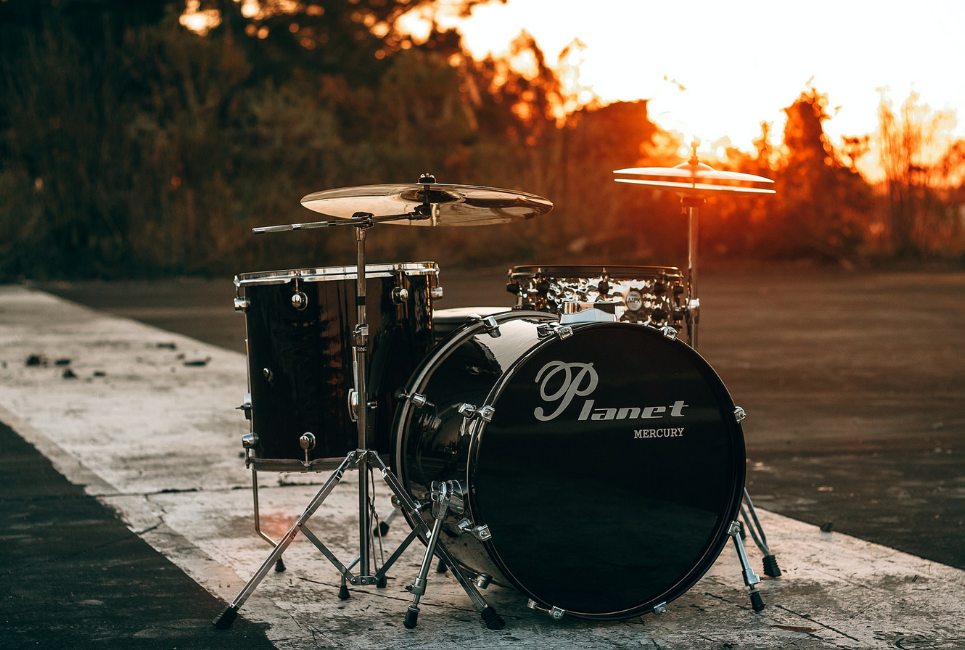- How to Find the Best Drum Pedals - December 8, 2021
- Best Marching Snare Drum Guide: With My Top 4 Recommendations - December 3, 2021
- Best Overhead Drum Mic Options - December 1, 2021
In order to choose an acoustic drum set for a studio or live performance, there are a number of considerations that must be made. You’ll need to understand what to look for, benefits and disadvantages, different types of acoustic kits, the components, and so on. Below is all the information you would ever need.
But first, let’s think about what an acoustic set of drums is and what the benefits are. There are two major types of drums: acoustic (the type you want to purchase) and electric. What’s the difference?
The major difference is simply in the name: acoustic drums can be heard from the kit itself, where electronic drums are heard through many different types of interfaces. Electronic drums have a nifty ability for volume control, where most acoustic sets can only be played at one volume: loud.
Steps in Purchasing an Acoustic Kit
Create a Budget
Don’t forget that most drum manufacturers provide a variety of grades of drums at various pricing points. These kits are still of good quality, and they frequently include many of the same features as the more costly kits, but at a lower price point.
If it is a popular drum brand, Yamaha, Gretsch, Tama, Sonor, you can be sure that these kits are usually top quality (even the budget option).
Define Your Soundscape
Where are the drums going to be played? For those who are more inclined to stay in one place, you might select shells that “fit” the room. If the drums are going to be traveling a great deal, select a set that’s simple to carry (the most flexible wood is maple).
What are You Playing?
Decide how many drums and cymbals you’ll need to achieve your musical ambitions here. This mostly depends on what you usually play. Jazz and rock drummers usually have different setups based on their music goals.
Decide on a Finish
This is probably the least important piece in the puzzle. In today’s market, drums come in a variety of finishes, ranging from raw wood to plastic covers. Examine the environment in which the drums will be placed.
A sturdy plastic cover that is resistant to bumps and scrapes may be the best choice if they are put up in a classroom. Stained wood may be the answer in a place of worship that requires a more aesthetic appearance. Most sets/brands have multiple finishes, so it shouldn’t be a dealbreaker.
Types of Acoustic Kits

The drum set that’s right for you depends on two things: where you’ll be playing and what kind of music you’ll be playing. Smaller drums tend to work better in smaller settings because they generate a tighter sound with fewer low-frequency resonances. Greater sound projection and sound propagation are advantages of larger drums.
These traditions include: funk and hip-hop kits prefer to utilize smaller drums to produce punchier sounds, whereas traditional rock kits use huge shells to get lower fundamentals and stage-ready projection.
These are some of the options:
Studio Kits
Drum sounds that can be readily miked without interference from room tone and extra harmonics are preferred by studio engineers — unless that is the desired effect. Yamaha Recording Custom, Pearl Session Studio Select, and DW Performance Series are among the most popular studio kits that have been used. Studio kits are best for one place, in the studio.
Jazz Kits
A jazz kit’s only difference is that it is usually smaller and easier to transport than other kits. A 14- to 18-inch bass drum may be “feathered” at low volumes without drowning out the rest of the band. The preference is for 4-piece kits that can be readily carried around town and are arranged one-up/one-down (kick tom, tom, floortom, snare).
Their tight, wide-open melodic tone makes jazz kits stand out from other types of drum kits. As a result of their compact size, jazz kits are often known as “club kits” by musicians and manufacturers alike. TAMA Club-Jam or Sonor AQ2 Bop kits are just a few examples of these jazzy club kits.
Fusion Kits
Fusion-sized kits are a size in between club kits and rock kits. They are kind of a do-all kit. There are 20-inch to 22-inch bass drums, as well as 10″/12″/14″ toms that are evenly spaced.
Fusion kits, despite their name, fulfill a broad spectrum of player demands, from blues to rock, stage to studio, and everything in between. Sonor SQ1, Pearl Decade Maple and Yamaha Stage Custom Birch kits are just a few examples.
Metal Kits
There are two main considerations when designing drum kits for punk, heavy metal, or current progressive music. Players can play swiftly and correctly without notes flowing into one another on a metal kit, while yet generating enough heat to blast through a dense stage mix.
Gallops and blast beats employ double bass drummers that are unique to metal kits. If you have a kit with two physical bass drums, such as the Pearl Masterworks Stadium Exotic, or a single bass drum that is controlled by a double bass pedal, you may get the desired result.
These kits are favored by Metal Hall of Famers like Lars Ulrich and Matt Garstka: Mapex Armory, SJC Navigator, and ddrum Dominion Birch.
Rock Kits
Drum kits designed for the stage tend to have bigger shells that are meant to produce more sound than those designed for the studio (i.e., greater thickness, denser materials). This same history is responsible for the dominance of big bass drums and cymbals in rock music.
Amber Ludwig Vistalite, with its 26-inch bass drum and one-up-two-down layout, is John Bonham’s (from Led Zeppelin) ultimate rock kit.
The addition of additional toms and floor toms for that wraparound appearance is also a typical feature of the rock/stage set. The PDP Concept Maple, the A&F Royal, and the SJC Heirloom are all excellent rock kits that are ready for the stage.
House Kits
Those acquainted with house and hip-hop music’s vinyl-sampled rhythms and crunchy breakdowns will be comfortable with these kits’ quick, controlled reaction.
As a result, today’s hip-hop and house drum kits include tiny shell sizes and smaller, more compact kick drums, which are ideal when backing either a small group or an individual emcee (similar to the jazz kit). In this bundle, Questlove of The Roots is responsible for creating the Ludwig Breakbeats series.
Additionally, the Pearl Midtown and Gretsch Brooklyn Micro are excellent choices for hip-hop/house sets.
Parts of the Kit
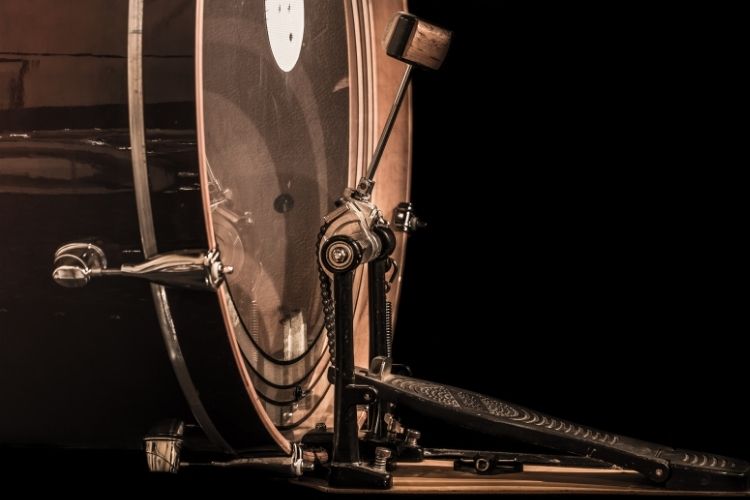
I know you’re probably asking yourself, what do I need exactly? There are tons of answers because, frankly, there are a ton of things that you need. Drums are not easy to buy, especially for a beginner. Let’s go over some of the ingredients you need to make this drum sandwich:
Kick Drum (Bass Drum)
It’s the lowest-pitched drum in the set. If you’re looking for the rhythmic foundation of a piece of music, you’ve found it!
Snare Drum
The kick drum is accompanied by a snare drum that has a unique snap. To help define the rhythmic structure, a snare drum is used.
Toms
When employed as “fills” between two sections of a song, their pitch ranges from high to low, and they add a lot of tonal richness. The number of toms might vary from one to three.
Cymbals
In a basic set, you’ll find hi-hat, ride, and crash cymbals. The “soprano” voices of the drum set are the cymbals.
Hardware
Musicians call it “hardware” since it’s the crucial gear that allows a drummer to perform. It contains a kick pedal, a snare stand, cymbal stands (including a hi-hat stand), tom holders, tom legs, and additional things as needed. Dimensions are approximate.
Shell Pack
Bass drums and toms make up most shell packs and nothing else. You’ll need to buy things like the snare drum (and stands) and pedals (and stands). A lot of drummers like their snare drum and associated gear in shell packs. Simply put, it’s the shell of your kit.
How Many Toms Should I Get?
If you’ve ever watched drummers in concert or on the screen, you’ve probably seen a lot of toms in their kits. However, the bass drum is the most important part of a drum set, followed closely by the snare and tom drums.
A tom is mostly utilized for “fills”—rhythmic phrases that serve as a transition from one portion of a song to the next in a song’s progression.
One tiny tom (typically positioned on the bass drum) and at least one large tom are required in a basic set (often called a floor tom). So, to answer this question, there is no answer! The number of toms you get is up to you (I recommend two).
Upper Head
An animal hide or plastic circular membrane is stretched over the drum’s shell with different degrees of tension to form the drum’s most basic component, the drumhead (tightness).
Upper Hoop
For tensioning the head on the shell, a contemporary drum hoop is usually composed of cast or stamped metal (although many drummers prefer wood hoops).
Tension Rod
In order to maintain the correct tension, tension rods are mounted via holes in the hoop and threaded into the lug.
Lug
To receive tension rods, metal lugs are usually installed in a shell. Designs for lugs can range from simple to quite complicated, and they frequently include alignment springs and other components.
Shell

After the head, the drum’s shell is responsible for much of its sound. In addition to wood, fiberglass, acrylic and other exotic shells may also be discovered in the oceans of the world.”
Vent
Any opening that permits air pressure to escape when the drumhead is hit might be described as a “vent.” Vents are not found on all drums.
Bottom Head
The resonant head of a drum plays a crucial role in determining both the attack and the tone. These heads are usually narrower than the top head.
Bottom Hoop
On the drum, the lower head is held in place by a bottom hoop. On snare drums, the bottom hoop has slots for the snares (see below).
Snare
This distinctive sound is created by the “Snare” drum’s coiled wire snares that are stretched over the drum’s bottom head.
Snare tension may be adjusted by using this lever-and-thread mechanism, which also disengages the snare from the head for a tom-like sound.
Snare Hoop
It has holes in its sides that allow the cables or straps holding the tasers to pass through.
The Drum Heads

Drum heads are the top layer of the drum (the layer that you actually hit with your drum sticks). They can be replaceable and are made from different materials. It has been 50 years since the first plastic head was invented, and drum heads and their technology have come a long way since animal skins stretched on logs.
Heads come in a variety of thicknesses, single-or multi-ply constructions, coated or transparent, and with reinforced centers or edges. It’s important to remember that moderation is the key when it comes to choosing: a medium-weight head that can be used for a variety of tasks is often sufficient for most situations.
Larger or thicker drum heads can handle the strain of hard-hitting and loud drummers. Overtones and ring can be reduced by using heads with sound-controlling centers and edges.
Cymbals

The range and features of cymbals are just too extensive to describe in this article. To complement the “thuddy” qualities of drums, cymbals give a metallic “soprano” spectrum of tones. Three of the most regularly used cymbals are listed below:
Ride
Along with the kick and snare, the ride is a medium-weight cymbal that helps establish the rhythmic foundation of a song. Ride cymbals can typically tolerate many blows without becoming excessively loud.
Crash
When struck on its edge, a thin, generally small-diameter cymbal creates an intense “crash.” Overtones from crash cymbals usually fade away fast, keeping them out of the way of the rest of the song.
Hi-hat
Actually two cymbals on a unique stand, one inverted above the other. Hi-hat cymbals are extremely adaptable, allowing them to be played “closed” with the pedal pressed down, “open” with the pedal up, and wherever in between. A beautiful “chick” sound may be achieved by just depressing the pedal without striking the cymbals.
Types of Wood
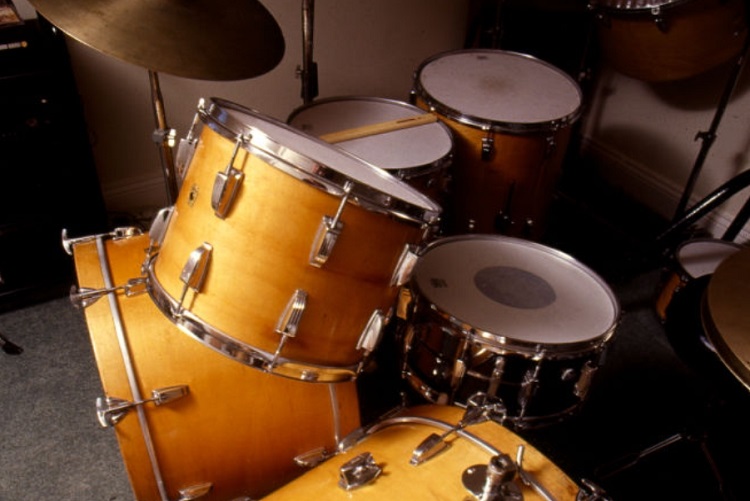
In most cases, drum shells are made of multiple thin layers of wood that are bonded together and twisted into form, often with the help of steam. A single layer of this wood is called a “ply”, therefore a multiple of these would be called a “multiply”.
Shells can be constructed from a variety of woods, similar to the tonewoods used to make guitars. As an example, consider the following types of wood and their pros and cons.
Mahogany
This wood is one of the softest and has a low fundamental tone, which gives it a punchy bottom end.
Maple
Maple has a medium hardness and a medium tone. When compared to harder woods, its pitch is higher than mahogany’s, yet it is still called “warm”. Maple has long been a favorite shell wood.
Birch
One of the toughest woods, Birch offers an upbeat tone with a strong transient assault. Birch is a popular choice for drummers in noisy live circumstances because of the loudness it can provide.
Bubinga
As well as being known as “African rosewood,” bubinga is now increasing in favor as an engineered hardwood. There are instances when the inner ply is made from this wood, while the outer ply is made from another type of wood.
Drum shell woods may be stained, painted, or wrapped in just about every finish conceivable, no matter what sort of wood they are made from. This just means that the type of wood is really about the sound and quality of your kit. It has nothing to do with the finish.
Personal Recommendations
Ludwig Breakbeats (LW)

Since its release in 2013, this compact drum set has been regarded as the king of micro kits for mobility, small stages, and even younger performers. A 16″x14″ bass drum, a 10″x7″ rack tom, and a 13″x13″ floor tom are included, along with a conventional 14″x5″ snare.
With a heavy tom-holder, smooth hoops, and a robust bass drum riser, the chromed shell hardware feels substantial. The real pro of this kit is that it is so easy to move and travel with. It is best for the road musician.
The bass drum is a prominent element. Although it’s unlikely to replace a larger kick in a traditional rock setup, the shell’s design and size allow it to function as a tiny cannon.
Even at lower tunings, the Breakbeats snare retains a lot of character, with a subtle trashy, grittiness, and a superb blend of snappy responsiveness and full-bodied overtones. When you crank it, you get a classic funk sound.
The tiny tom diameters don’t lend them a ‘power-tom’ sound, but around the mid-tension sweet spot, you can force a big, clear, sustained note out of them.
Ludwig has now added black, white, and red sparkle finishes, as well as the all-new Sahara Swirl, to the original Azure Blue Sparkle finish. The Breakbeats are a difficult kit to criticize for the money.
Pros
Small, easy to travel with, the bass has incredible sound, easy to tune
Cons
Not incredibly powerful
Yamaha Custom (in birch)
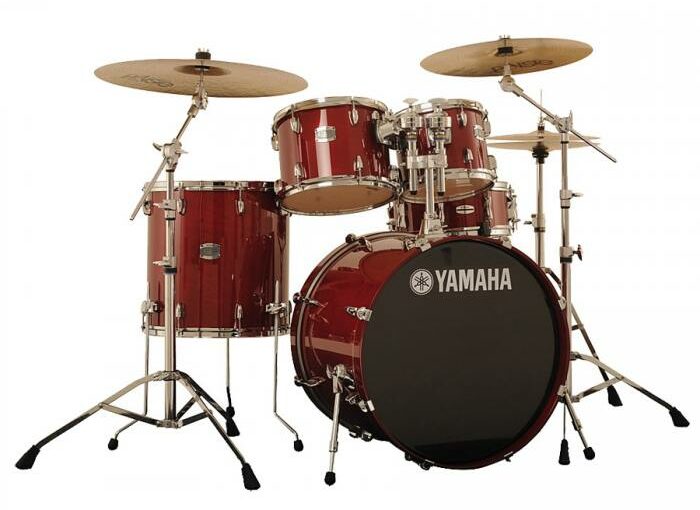
For over three decades, the Yamaha Stage Custom has been a classic mid-priced kit, and the manufacturer has continued to improve the configuration to keep it relevant.
Yamaha’s track record with birch shell construction speaks for itself. The 6-ply shells of the Stage Custom are 6.6mm thick, straight-sided, and butt joined using Yamaha’s signature diagonal seams, with bearing edges precisely trimmed at 45 degrees.
The bass drum is dead on when it’s wide open, providing a tremendous wallop of low-end. With a breathy decay, it’s an unabashedly resonant kick.
The toms are likewise aggressive, with fast, thick notes delivered at amp-beating levels. Birch shells provide focused-sounding drums in general, and the toms rapidly tune to that point.
The snare drum delivers a bright, birch-like performance, with tuning changes handled with ease, whether tightening to a distinctive crack or relaxing to a broad clonk.
Like the inscriptions on a piece of rock, Yamaha’s credentials flow through the Stage Custom Birch. It’s beautifully crafted, robustly designed to withstand the rigors of everyday use, and delivers sound that belies its price tag. This is a kit that will last a long time.
Pros
Last a lifetime, high quality sound, stylish to look at
Cons
More expensive
Gretsch Catalina Club
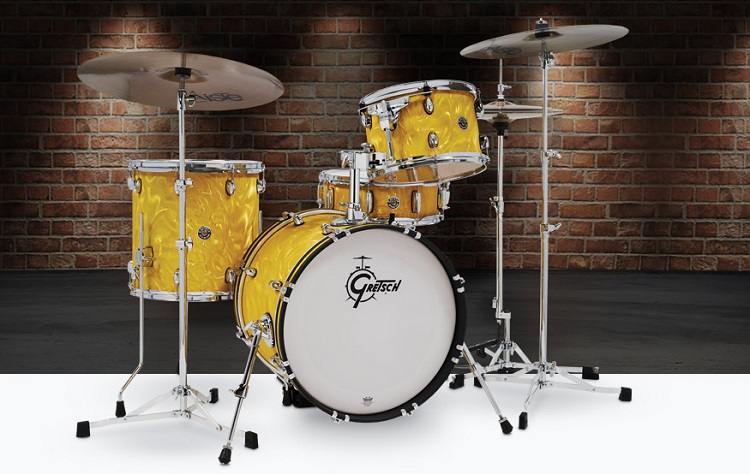
With a plethora of stunning finish possibilities, some pretty unique shell combinations, and vintage-style bags, it’s no wonder that the Catalina Club is one of Gretsch’s most inexpensive and popular kits.
One of the Catalina Club’s most appealing characteristics is the way it combines antique components with dependable contemporary gear. Whether you’re playing be-bop or Bonham, every setup revolves around a 14-inch deep bass drum, which provides smooth and powerful tones on which to create the rest of your sound.
These drums have a warm, deep resonance and a 30 degree bearing edge to assist your performance transcendence.
Unfortunately, tuning these drums-particularly the 5-lug rack toms-is extremely tough. The tension of the head is rarely the same all the way around due to the large distance between each lug.
Still, when you get it right-even with a little pitchy rack tom-these drums sound amazing, and if you’re looking for a big, dry sound, it may even work in your favor.
Pros
Deep resonant sound, affordable but with Gretsch quality
Cons
Tuning is difficult
Canopus RFM 5pc Drum Set
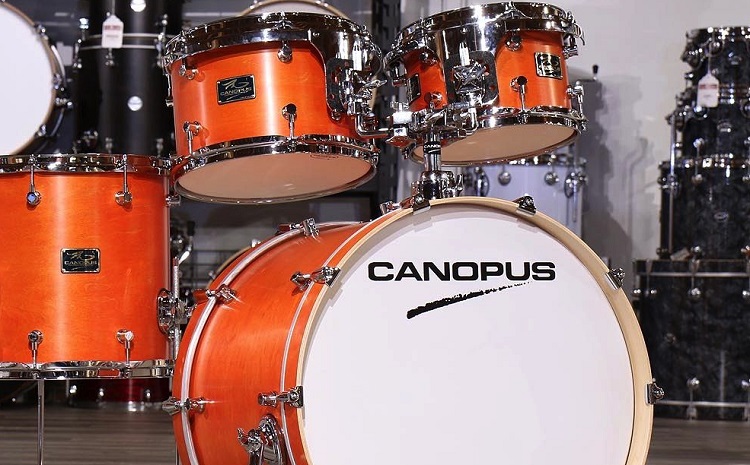
This shell set includes three 22×15, 10×7, and 12×8 toms, as well as two 14×13 and 16×15 floor toms. We love the smooth finish on this set, as well as the meticulous thought that went into developing the maple shell drums.
Canopus noted several things that were going extremely well as they created their R.F.M series, such as the robust sound it provided.
It’s also a fantastic choice for various types of music, which is difficult to come by in most setups. It’s remarkable how versatile it is. The designers of this drum set also considered some of the disadvantages of maple shell sets. Maple was found to be insufficiently resonant.
There were some unwelcome overtones, and the mid-range wasn’t strong enough. With these considerations in mind, they created the RFM series to address all of these difficulties and provide a clean, bright sound.
Only the drums and mounting hardware are included with this kit; the hardware, snare drum, and cymbals must be purchased separately.
Pros
Awesome for any genre, high quality, beautiful
Cons
Cymbals are not included,
FAQ
Answer: Acoustic drum kits can cost anywhere from $200 USD to anywhere above $2000. Professional kits are more expensive while beginner ones will be less pricey.
Answer: It depends on your definition of “too loud”. Acoustic drums are one of the loudest instruments and really can not be played quietly. If you’re looking for a quiet set that is better check out electronic drum kits.
Answer: This will be different according to each individual drummer. In my opinion, Gretsch, Ludwig, and Sonor make some of the best drums.
Answer: The consensus for the temperature of drums is to keep them at a temperature that you also feel comfortable in. If it is too cold your drums will fall out of tuning. The same may happen if it is too hot.
Conclusion
Choosing an acoustic kit is hard… I know. Go to your local music store, test some kits out, talk to the experts, and get to know each kit. It’s hard to buy something when you don’t understand what you’re buying.
Remember that this guide is here for you as well. You can continue to research your kit and things you should look for with this guide. Good luck, and get to searching.
I recommend trying the Gretsch Catalina Club. This is a cheaper option but still has the Gretsch tag, meaning it will last you a lifetime. It is fun to play and easy to sit down and enjoy.
Looking for more interesting readings? Check out:

